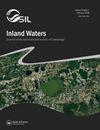快速融化断续冻土泥炭地浅层湖泊的湖泊学和硅藻生态学
IF 2.3
3区 环境科学与生态学
Q1 LIMNOLOGY
引用次数: 0
摘要
不连续的永久冻土泥炭地中的湖泊处于气候变化的前沿,对气温的轻微升高也很敏感。本研究的目的是提供Scotty Creek盆地(加拿大西北地区)浅层(~ 1-2米深)湖泊的第一个湖泊特征,由于存在数十年来的长期生态水文监测,这是一个具有环极地意义的野外地点。我们利用之前的工作作为基础,推进我们对湖泊生态系统变化潜在驱动因素的基于过程的理解。我们的研究结果表明,溶解有机碳(DOC)和湖泊颜色不相关,这种模式似乎是这些湖泊中硅藻(硅质单细胞藻类)组合的重要驱动因素。研究湖泊中的硅藻往往属于2个组合簇中的1个。一个由底栖小水蛭科(Fragilariaceae)和小Navicula种(sensu lato)组成的群落与较高的湖泊颜色相关;第二个群落由褐藻和大型Navicula组成,DOC高,颜色低,底栖苔藓垫的存在。从这一发现,我们认为DOC质量是该地区湖泊生态的主要控制因素,因为它控制了光穿透湖底的作用。我们的假设是,近岸沼泽和崩塌疤痕湿地的流行将是DOC的重要驱动因素,但这一假设在9个研究湖泊中没有得到现有岸线特征地图数据的支持。本文章由计算机程序翻译,如有差异,请以英文原文为准。
Limnology and diatom ecology of shallow lakes in a rapidly thawing discontinuous permafrost peatland
ABSTRACT Lakes in discontinuous permafrost peatlands are on the front lines of climate change, sensitive to even modest increases in air temperature. The aim of this study was to provide the first limnological characterization of shallow (∼1–2 m depth) lakes in the Scotty Creek basin (Northwest Territories, Canada), a field site of circumpolar significance due to the existence of long-term ecohydrological monitoring going back decades. We use this previous work as a foundation to advance our process-based understanding of the potential drivers of lake ecosystem change. Our results showed that dissolved organic carbon (DOC) and lake color were not correlated, a pattern that seems to be an important driver of diatom (siliceous single-celled algae) assemblages in these lakes. Diatoms in the study lakes tended to fall into 1 of 2 assemblage clusters. One cluster, composed of small benthic Fragilariaceae and small Navicula species (sensu lato), was found associated with higher lake color; the second cluster, composed of Encyonopsis and large Navicula species, was found associated with high DOC, lower color, and the presence of a benthic moss mat. From this finding, we suggest that DOC quality is a primary control on lake ecology in this region for its role in controlling light penetration to the lake bottom. Our hypothesis that the prevalence of nearshore fens and collapse scar wetlands would be important drivers of DOC was not supported in the 9 study lakes with available data to map shoreline features.
求助全文
通过发布文献求助,成功后即可免费获取论文全文。
去求助
来源期刊

Inland Waters
LIMNOLOGY-MARINE & FRESHWATER BIOLOGY
CiteScore
6.10
自引率
9.70%
发文量
34
审稿时长
>12 weeks
期刊介绍:
Inland Waters is the peer-reviewed, scholarly outlet for original papers that advance science within the framework of the International Society of Limnology (SIL). The journal promotes understanding of inland aquatic ecosystems and their management. Subject matter parallels the content of SIL Congresses, and submissions based on presentations are encouraged.
All aspects of physical, chemical, and biological limnology are appropriate, as are papers on applied and regional limnology. The journal also aims to publish articles resulting from plenary lectures presented at SIL Congresses and occasional synthesis articles, as well as issues dedicated to a particular theme, specific water body, or aquatic ecosystem in a geographical area. Publication in the journal is not restricted to SIL members.
 求助内容:
求助内容: 应助结果提醒方式:
应助结果提醒方式:


